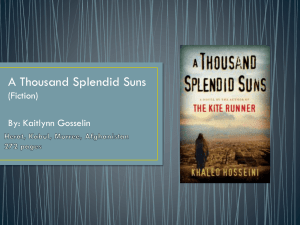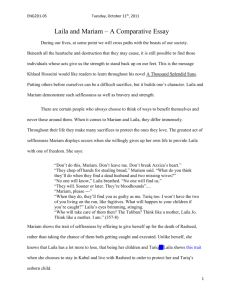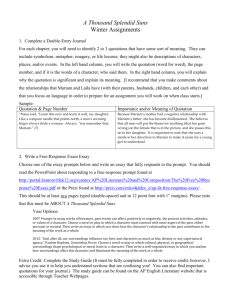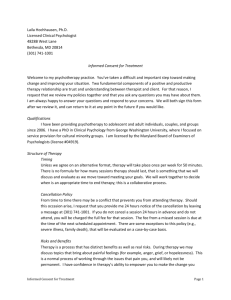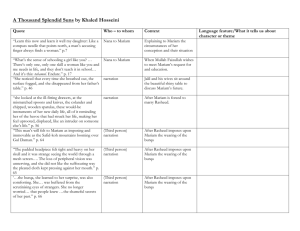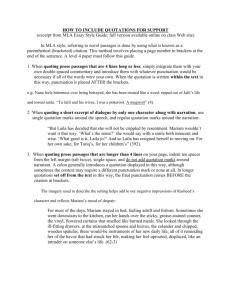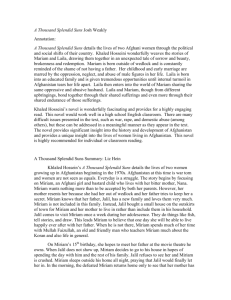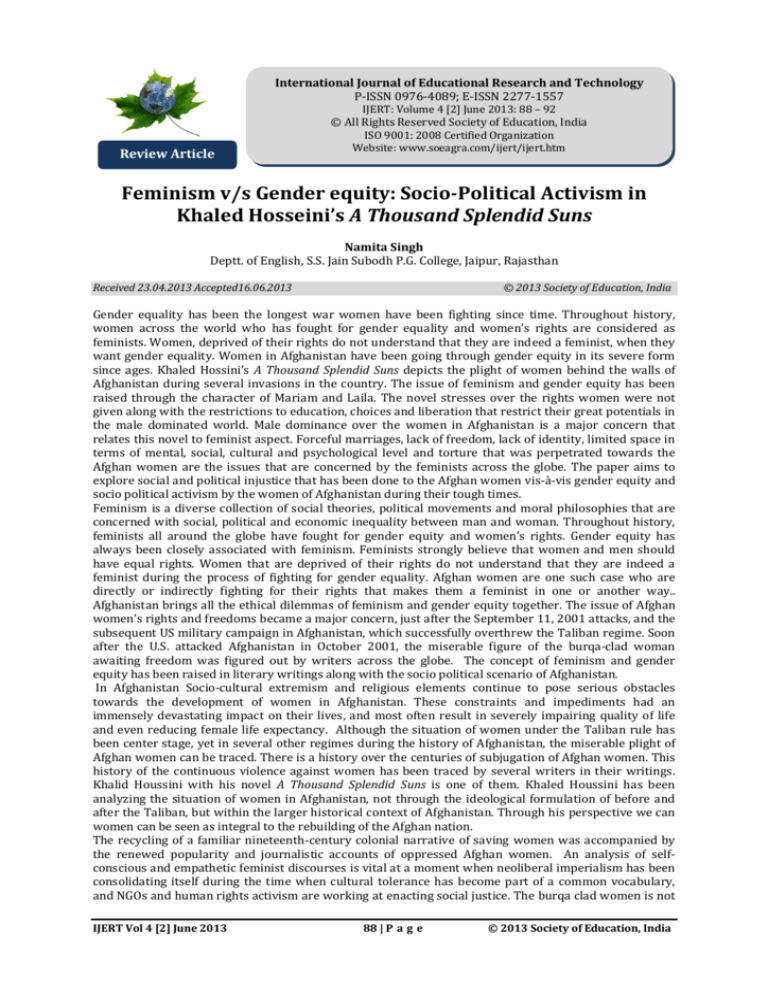
International Journal of Educational Research and Technology
P-ISSN 0976-4089; E-ISSN 2277-1557
IJERT: Volume 4 [2] June 2013: 88 – 92
© All Rights Reserved Society of Education, India
Review Article
ISO 9001: 2008 Certified Organization
Website: www.soeagra.com/ijert/ijert.htm
Feminism v/s Gender equity: Socio-Political Activism in
Khaled Hosseini’s A Thousand Splendid Suns
Namita Singh
Deptt. of English, S.S. Jain Subodh P.G. College, Jaipur, Rajasthan
Received 23.04.2013 Accepted16.06.2013
© 2013 Society of Education, India
Gender equality has been the longest war women have been fighting since time. Throughout history,
women across the world who has fought for gender equality and women’s rights are considered as
feminists. Women, deprived of their rights do not understand that they are indeed a feminist, when they
want gender equality. Women in Afghanistan have been going through gender equity in its severe form
since ages. Khaled Hossini’s A Thousand Splendid Suns depicts the plight of women behind the walls of
Afghanistan during several invasions in the country. The issue of feminism and gender equity has been
raised through the character of Mariam and Laila. The novel stresses over the rights women were not
given along with the restrictions to education, choices and liberation that restrict their great potentials in
the male dominated world. Male dominance over the women in Afghanistan is a major concern that
relates this novel to feminist aspect. Forceful marriages, lack of freedom, lack of identity, limited space in
terms of mental, social, cultural and psychological level and torture that was perpetrated towards the
Afghan women are the issues that are concerned by the feminists across the globe. The paper aims to
explore social and political injustice that has been done to the Afghan women vis-à-vis gender equity and
socio political activism by the women of Afghanistan during their tough times.
Feminism is a diverse collection of social theories, political movements and moral philosophies that are
concerned with social, political and economic inequality between man and woman. Throughout history,
feminists all around the globe have fought for gender equity and women’s rights. Gender equity has
always been closely associated with feminism. Feminists strongly believe that women and men should
have equal rights. Women that are deprived of their rights do not understand that they are indeed a
feminist during the process of fighting for gender equality. Afghan women are one such case who are
directly or indirectly fighting for their rights that makes them a feminist in one or another way..
Afghanistan brings all the ethical dilemmas of feminism and gender equity together. The issue of Afghan
women’s rights and freedoms became a major concern, just after the September 11, 2001 attacks, and the
subsequent US military campaign in Afghanistan, which successfully overthrew the Taliban regime. Soon
after the U.S. attacked Afghanistan in October 2001, the miserable figure of the burqa-clad woman
awaiting freedom was figured out by writers across the globe. The concept of feminism and gender
equity has been raised in literary writings along with the socio political scenario of Afghanistan.
In Afghanistan Socio-cultural extremism and religious elements continue to pose serious obstacles
towards the development of women in Afghanistan. These constraints and impediments had an
immensely devastating impact on their lives, and most often result in severely impairing quality of life
and even reducing female life expectancy. Although the situation of women under the Taliban rule has
been center stage, yet in several other regimes during the history of Afghanistan, the miserable plight of
Afghan women can be traced. There is a history over the centuries of subjugation of Afghan women. This
history of the continuous violence against women has been traced by several writers in their writings.
Khalid Houssini with his novel A Thousand Splendid Suns is one of them. Khaled Houssini has been
analyzing the situation of women in Afghanistan, not through the ideological formulation of before and
after the Taliban, but within the larger historical context of Afghanistan. Through his perspective we can
women can be seen as integral to the rebuilding of the Afghan nation.
The recycling of a familiar nineteenth-century colonial narrative of saving women was accompanied by
the renewed popularity and journalistic accounts of oppressed Afghan women. An analysis of selfconscious and empathetic feminist discourses is vital at a moment when neoliberal imperialism has been
consolidating itself during the time when cultural tolerance has become part of a common vocabulary,
and NGOs and human rights activism are working at enacting social justice. The burqa clad women is not
IJERT Vol 4 [2] June 2013
88 | P a g e
© 2013 Society of Education, India
Namita Singh
the object of Western feminist concern only. Separated from the self-individuated Western subject, it is an
active agent who challenges women to recognize their common oppression. Prior to this, Afghanistan’s
distance from modernity has been represented by several writers through traditional signifiers of Islamic
backwardness such as arranged marriages, calls to prayer, and bearded men etc. Along with such issues
now-a-days feminism and the issues of gender equity and activism has taken place in their writings.
Khaled Houssini has written about the plight of Afghan women along with the socio political scenario of
Afghanistan. His novel A Thousand Splendid Suns depicts the plight of women behind the walls of
Afghanistan during several invasions in the country. The issue of feminism and gender equity has been
raised through the character of Mariam and Laila. Both of their fates are connected through a tragic twist
of circumstances. However, because of the status of women within the society, their decisions are forced
on them. Mariam had to marry Rasheed a shoemaker who is many years elder to her, because her father
and his wives force her to do so. Her acceptance is merely a token of act. Laila, the other protagonist had
to marry Rasheed because she was orphaned and pregnant. Both situations are untenable in her society.
The novel stresses over the rights women were not given along with the restrictions to education, choices
and liberation that restrict their great potentials in the male dominated world.
Although feminist understanding having a specific language of tolerance and empathy, reflects the
emergence of a far more self-conscious discourse. This discourse has been emerged from recognition of
the shortcomings of imperial feminism not only in academia but in popular media. In a range of genres
like journalistic accounts, memoirs, critical documentaries, literature about Muslim women, and websites
of humanitarian organizations in Afghanistan, the Issue of women has became very important. Rescue of
Afghan women has been a central narrative since 9/11 that presents Afghanistan as a cultural site to
tease out the convergence of cross-cultural identification and imperialism.
In the novel A Thousand Splendid Suns by Khaled Hosseini, Laila stresses over the rights women were not
given. Laila’s restrictions to education, choices and liberation also restrict her great potentials due to the
male dominated world. Her early life shows great potential in education throughout school, many
opportunities and free from everyone’s words and ownership. This all soon changed as she grows up and
people in her environment considers her a woman and no longer a mere girl. As she becomes a woman,
she also becomes a feminist. The novel also stresses over restrictions to education, choices and liberation
that restrict their great potentials in the male dominated world. It depicts a gradual adherence of women
towards the rules and regulations made against them by the society as in case of Laila. Throughout her
life she has struggled to obtain freedom from any man and as she grown up and becomes a woman, she
slowly sees the position she sits in the world. The ideas of women rights are superseded. Laila finally
realizes that the world is male dominated but still she doesn’t lose hope. Women are considered
properties to men in this world. Rasheed, a very domestically violent 60 year old husband of Laila,
explained very clearly that “A women’s face is her husband’s business only” (Hosseini 48). This quote
gives an example of a male warning a female, Rasheed to Laila, that he is the owner over Laila. When
Rasheed goes through rough time, the comfort of Laila was not appreciated nor respected. “The day will
come when men will recognize woman as his peer, not only at the fireside”. As Laila tries her best to
satisfy Rasheed, she was nothing but a means of satisfying his physical needs, something Rasheed will
pull out and use when needed. Laila is only another piece of property Rasheed uses like a car, a house or a
gun. Laila’s only use was granting Rasheed a child. This is considerably the argument stated in which
women are only properties to the male superior.This is the case with most of the women in Afghanistan.
They were treated as an object not as a human being.
Other victim, Mariam constantly faced and blamed for circumstances that were out of her control. She
never did anything wrong, yet had to endure a lifetime of hardship.She was a selfless human being cursed
for being a woman. Her illimitable plagued her as well, in ways we would imagine it would not have had
she been a boy. These line are the prophetic lines said by Mariam’s mother when she was a child that
came true in her life after some years.
“In a few years this little girl will be a woman who will make small demands on life, who
will never burden others, who will never let on that she too has had sorrows,
disappointments, dreams that have been ridiculed. A woman who will be like a rock
in a Riverbed, enduring without complaint, her grace not sullied but shaped by the
turbulence that washes over her.”(4)
The History of Afghanistan had its impact on the people, particularly the women living in Afghanistan.
Mariam could have had a better life, if she had not gone to Jalil’s house, instead staying with her mother.
Yet, that would not have stopped the Civil War, Soviet invasion, Taliban, or the prospect of a different but
equally sadistic husband. Mariam’s destruction was out of her control. This depicts the role of social
political scenario on the life of Afghan women who are victimized from all sides. Laila’s struggle was a
IJERT Vol 4 [2] June 2013
89 | P a g e
© 2013 Society of Education, India
Namita Singh
different one to Mariam’s. She grew up with happiness, love and freedom, her transition from everything
to nothing was not easy. At times we find her ungrateful for Mariam however their bond was great.
The issue of health care, especially for women, is apparent to a great extent in A Thousand Splendid Suns,
When Laila is ready to give birth to her son, only one hospital in all of Kabul serves women. This hospital
is severely short of staff and lacking in medicine and anesthetic. It seems extreme to portray a cesarean
section without anesthetic, but this is historically correct. Laila was to be operated on without any sort of
medication during the time of Fundamentalist regime in Afghanistan indicates the hypocrisy of the male
dominated society where women were so segregated that sanitary medical conditions, let alone mixed
gender hospitals, were denied. The strength these women had shown during the tough time was
magnificent and shows the activism on their part. Kabul had only one hospital for women, few doctors
were working there, and they had little or no medicine or means to anesthetize their patients:
…The doctor took a breath, then told Laila that the hospital had no anesthetic….”Then cut me open”, Laila
said. She dropped back on the bed and drew up her knees…”Cut me poen and give me my baby.”(259).
These were the circumstances through which Afghan women were going during the horrified reign of
Taliban.
It is love that draws characters out of their isolation that gives them the strength to transcend their own
limitations, to expose their vulnerabilities, and to perform devastating acts of self-sacrifice. A Thousand
Splendid Suns shows the social and cultural–and, ultimately, political–structures that support the
devaluation, degradation, and violence endured by Mariam and Laila. Severely undermining women’s
human rights, they had to endure everything in the novel and their confessions do not put value which the
maximizing of domination. There is a question that male and female both take birth with the same way of
pregnancy of their mother while gradually behavior of gradation starts by the society and the same
society starts maintaining the level. In Afghanistan one can find this case in extreme.
The women in the novel often work to retain hope while dealing with the realities of political and
personal oppression. At significant points throughout the novel, characters express their individual
hopes. For instance, when Mariam asks Mullah Faizullah if she may attend school, her journey of hope
begins. For Laila, hope lies in Tariq and an attempted escape from Rasheed. Most characters walk into
such events with high levels of hope for the future, but once reality sets in, a character's hope is crushed.
Not only do these waves of hope provide the reader with suspense and emotional attachment to the
characters, but this cycle appears to reflect the cycles of hope and dashed dreams that Afghan women
suffer over the period of time. The personal stories of hope are mirrored in the political hope of the
Afghan citizens.
Jalil and Rasheed emphasize the importance of their reputations by doing their best to avoid any shame to
their names. Jalil thus takes action by casting Nana out of his house once she becomes pregnant with his
illegitimate child. He also does not keep his promise to take Mariam into town with him. He also marries
off Mariam to Rasheed after Nana's death. For his part, Rasheed notes that he would need to marry Laila
because he could not have her living in his house without some sort of pretense otherwise, people would
gossip about him. He also spends beyond his family's budget in order to make it seem that his family has
wealth. Ironically, both men behave in ways that are ethically shameful. To protect their names in order
to meet their own ideas of social expectations, they neglect or even abuse their offspring and wives,
sacrificing the welfare of those around them.
Hosseini sets up pregnancy as a symbol of hope throughout the novel. Mariam's each pregnancies offer
her an opportunity to be hopeful for the future despite her bleak living situation. Laila's pregnancy with
Aziza allows her to remain positive after she learns about Tariq's death. Aziza and Zalmai thus offer light
and joy to a story that is otherwise bleak and dark. Childbirth is painful, and the pain that mothers feel
during the various birthing scenes reminds us of the sacrifices that parents make in order to bring new
life into the world. The mother’s pain is worth the joy and attachment that she feels once the child is born.
Additionally, the contrast between fertility and infertility has a traditional meaning: a woman's value in
Afghan society has often been measured by her ability to bear children, specifically boys. Mariam was
abused by her husband throughout her life because she was unable to give him a child. Later on Laila was
also abused by Rasheed because she gave him a baby girl as her first child.
The women in A Thousand Splendid Suns have very different educational experiences. Mariam is tutored
by Mullah Faizullah in the Koran, and she learns how to read and write. Yet, when she asks her mother
about going to school, Nana insists that the only lesson that Mariam needs to learn is to endure. This
shows the social set up against women who were made to learn endurance since their childhood. While
on the other hand Laila’s father emphasizes the importance of her education. Hakim diligently works
with Laila on her homework and provides her with extra work in order to expand her education. He
emphasizes that Laila's education is as important as that of any boy. After the streets of Kabul become too
dangerous, he insists on tutoring Laila himself. He comments about the importance of women attending
IJERT Vol 4 [2] June 2013
90 | P a g e
© 2013 Society of Education, India
Namita Singh
universities. Aziza is educated by both Laila and Mariam, who contribute what they know in order to
educate her. Mariam teaches the Koran, and Laila eventually volunteers to teach at her school. The end of
the book feels hopeful in terms of the education of women in that Zalmai and Aziza head off to school
together.
A clear distinction is made throughout the novel between true love and marriage. Since the marriages in
the novel tend to be forced, they are not likely to be influenced by love. For Nana, the prospect of
marriage was ruined by a ‘jinn.’ She remembers the lost prospect fondly. Mariam finds hope in her
marriage as something that could lead to contentment and possibly to love, but the marriage actually
devolves into abuse and oppression. Only Laila escapes the abusive bonds placed on her by Rasheed when
she finds true love with Tariq. The contrasts between forced marriage and true love are obvious once
Laila and Tariq finally are able to marry and live as a family. Daily living in a forced marriage, for Laila,
involved disgust and futile hopes for a better future. With Tariq, in contrast, daily routines leave Laila
content and fulfilled. Sexual relations between Laila and Rasheed were completely one-sided, with
Rasheed forcing himself upon Laila. With Tariq, however, Laila finds safety in making love. Perhaps most
importantly, Laila felt fearful and restrained with Rasheed, but she can be honest and brave once she
finds true love with Tariq.
The women forge strong bonds despite the efforts of their husbands and their government to reduce
women’s power. The bonds differ in nature. For instance, Giti, Hasina, and Laila form a bond of girlish
friendship, but Mariam and Laila form a much more powerful familial bond later in the novel. Nana finds
strength from her daughter Mariam, and Mariam finds an admirer when she arrives in a Talibancontrolled prison. The novel thus suggests that women have a strong ability to find strength and support
in one another. Mariam never would have gained the strength to fight Rasheed if she had not gained
confidence and love from Laila.
‘The freedoms and opportunities that women had enjoyed between 1978 and 1992 were a thing of the
past now’ Laila could still remember Babi saying of those years of communist rule, ‘It’s a good time to be a
woman in Afghanistan, Laila.’ Since the Mujahedeen takeover in April 1992, Afghanistan’s name had been
changed to the Islamic State of Afghanistan. The Supreme Court under Rabbani was filled with hardliner
mullahs who did away with the communist-era decrees that empowered women and instead passed
rulings based on Shari’a, strict Islamic laws that ordered women to cover, forbade their travel without a
male relative, punished adultery with stoning. The women are cruelly beaten and confined on their return
“home,” and when their husband releases them, starving and broken, they and he know the truth of his
words: “You try this again and I will find you. I swear on the Prophet’s name that I will find you. And,
when I do, there isn’t a court in this godforsaken country that will hold me accountable for what I will
do.”These are the words spoken by Rasheed to Laila depicting his male dominance over hapless women.
Rasheed’s words are the representation of the social structure against the women during the reign of
Taliban.
When the Taliban move in Afghanistan, the control they assert over women’s conduct and liberties was
just an extreme form of what women in Afghanistan were already enduring. Transferring completely to
the public sphere what has been considered acceptable already in the household namely, the horrors
inflicted on women by men who cannot be held accountable. The female characters in A Thousand
Splendid Sons connects gender equity and feminism by accentuating the parallels between the class and
gender struggle facing by them. Rasheed’s marriage to Mariam and Laila is one representation of
marriage in Afghanistan. However, Laila’s parents married for love. They were cousins, which is common
and even preferred in Afghanistan, but their marriage was not arranged. Laila’s father is in the weaker
position in the marriage, with the mother influencing decisions and the tenor of domestic life. Nana,
Mariam’s mother, had been engaged to ayoung man in the more typical manner of an arranged marriage.
Her illness, perhaps epilepsy, or as she calls it, her Jinn, became apparent before the engagement was
finalized, and the suitor’s family abandoned her. This abandonment was a stigma that Nana carried with
her to her death. Mariam’s father, Jalil, has several wives in the same manner as Rasheed. The impression
given is that his is a domestically peaceful arrangement. Jalil and his wives are compatible and all make
decisions together. The wives together are able to influence Jalil to marry off Mariam, a decision that he
accepts but soon regrets. Laila and Tariq are perhaps the fairy tale romance of the novel. They are neither
cousins nor even of the same ethnic background. They are childhood friends who drift into a romantic
attachment at an early age. Presumably parted for
life, they find each other again, older, wiser, and painfully more experienced.
For Mariam, the illegitimate child of a lower class woman and a prominent Afghan patriarch, freedom is
the ability to read, write, and play, even though her illicitness has banished her and her mother to the far
reaches of their village. Mariam’s freedoms are even further suppressed when her father sells her to the
Rasheed, the epitome of the hierarchical male.Rasheed’s physical and mental dominance reduces Mariam
IJERT Vol 4 [2] June 2013
91 | P a g e
© 2013 Society of Education, India
Namita Singh
to a cringing and crippled object of oppression when they find she cannot conceive a child to carry on his
name. Years later, Laila enters as Rasheed’s second wife. Younger and still conceivably feminist, Laila is
decisively more combative with Rasheed, which makes life even worse for Mariam, who has basically
been reduced to a punching bag. As these two women overcome their social differences, they join forces
to free themselves from Rasheed’s own brand of dictatorship. Although Mariam has long been jaded by
Rasheed, Laila still clings to her feminist values. She helps Mariam find her voice and together they both
find their freedom again; through life or through death.
The oppression of women in Afghanistan is linked to a world of male dominance most significantly
associated with the Islamic fundamentalist group the Taliban in the early 1990s. It was during this period
that the last signposts of Marxism were torn down, and the rights of women were completely abolished.
For Mariam and Laila, the day the Taliban rolled their tanks through Kabul was not their first encounter
with repression, but it was the final event that would bolster their feminist ideals and lead them on a
journey to reinstate the values of gender and class equality that was sorely missed. Mariam’s Journey
from unwanted child towards a belittled and barren wife shows the wretched plight of Afghan women.
From a feminist perspective, Mariam’s role as a woman and caregiver is penalized by her inability to
conceive. Her lack of hierarchical birthright puts her in a lower class. In the text, Mariam assumes the
quintessential role of the other. since she succumbs to this discourse instead of fighting it, she not only
affirms bourgeoisie values, but let’s fade the little feminism she has left. Secondly Laila, the younger, more
idealistic, more outspoken of the women acts as the antithesis of the bourgeoisie and a prominent force of
radical feminism. As a feminist, she retaliates against her allotted discourse as a male-owned object. She
also reflects the belief of class equality by maintaining and stimulating a familial relationship with the
lower class Mariam.
The actions of these characters symbolizes their strength to endure things as they join together in
feminist retaliation against the man who has taken away their rights to live according to their own choice.
In A Thousand Splendid Suns , two generations of characters brought inharmoniously together by the
tragic sweep of war, where personal lives, the struggle to survive and to raise a family, to find happiness,
are inextricable from the history playing out around them. In The Thousand Splendid Suns, the story of
Afghanistan includes the story of the role and place of women in Afghan society. Khaled Hossini has
keenly examined the condition of women in this novel. Laila is the beloved daughter of her father, but her
mother focuses primarily on Laila’s brothers. Laila has been forgotten in her mother’s grief for the loss of
her two sons. Mariam, in contrast to Laila, lives in poverty but has the rough love of her mother and the
apparent doting of her father. Both girls’ lives change abruptly and clearly for the worst when they
become connected to Rasheed through marriage. Both of them are ruled by his wishes and desires and
defy him at great risk to their well being, and in Laila’s case, the well-being of her children. It may pass
through the mind of the reader to wonder whether Hosseini has overstated his case. Rasheed’s treatment
of Mariam predates the Soviet invasion and the civil war, and his relationship with both Laila and Mariam
predates the Taliban. At no time does it appear that Laila or Mariam have any legal rights. But Hosseini
carefully portrays both Laila, whose parents raised her with a greater sense of entitlement and privilege,
and Mariam, whose mother taught her to endure by taking control of the conditions under which they
lived to the extent that they possibly could and He has very cleverly shown feminism and activism on
their part at some extent.
REFERENCES
1.
2.
3.
4.
Hosseini,Khalid (2007).. A Thousand Splendid Suns. New York: ATSS Publications LLC.
Ellis, Deborah (2000).. Women of the Afghan War. Westport, CT: Praeger.
Emadi, Hafizullah (2002). Repression, Resistance, and Women in Afghanistan. Westport, CT: Praeger.
Falah, Ghazi-Walid, and Caroline Rose Nagel.(2005). Geographies of Muslim Women: Gender, Religion, and
Space. New York: The Guilford Press.
5. Iacopino, Vincent, and Physicians for Human Rights (U.S.). The Taliban’s Waron Women: A Health and Human
Rights Crisis in Afghanistan: A Report.
6. Boston: Physicians for Human Rights, 1998.
7. Mehta, Sunita, ed. Women for Afghan Women: Shattering Myths and Claimingthe Future. New York: Palgrave
Macmillan, (2002).
8. The Women of Afghanistan Under the Taliban. Jefferson, NC: McFarland, 2002.
9. Adamec, Ludwig. Historical Dictionary of Afghanistan. 3rd ed. Lanham, MD: Scarecrow Press, 2003.
10. Epistemic Violence, and the Rhetoric of the Veil.’’ NWSA Journal 17, no. 3 (2005): 112–133. Azad, Farhad.
‘‘Dialogue with Khaled Hosseini Afghan Magazine.’’
11. Bookbrowse.comandKhaledHosseini.‘‘AuthorInterviews:KhaledHosseini.’’Bookbrowse.com,(2007).
HOW TO CITE THIS ARTICLE
Namita Singh. (2013). Feminism v/s Gender equity: Socio-Political Activism in Khaled Hosseini’s A Thousand Splendid
Suns. Inter. J. Educat. Res.Technol., Vol 4 [2] : 88- 92
IJERT Vol 4 [2] June 2013
92 | P a g e
© 2013 Society of Education, India

